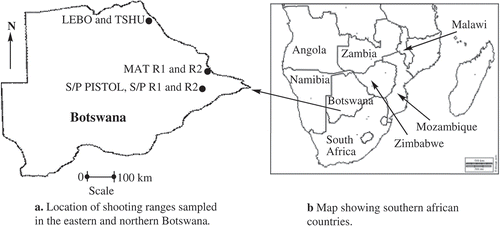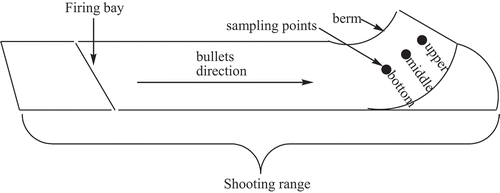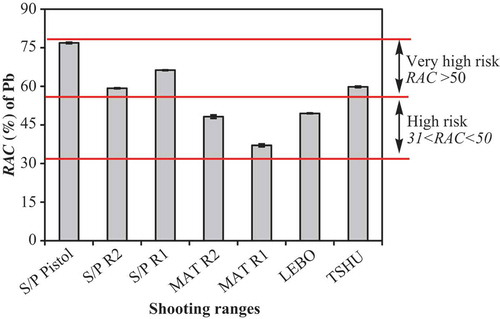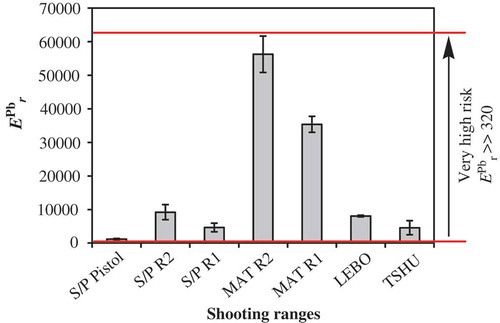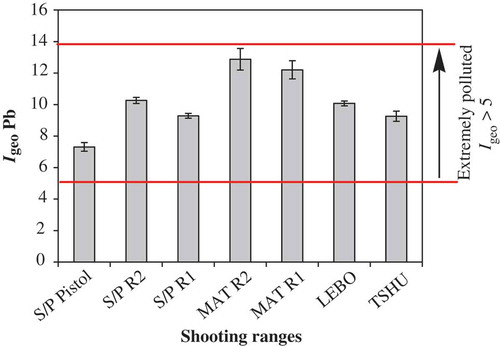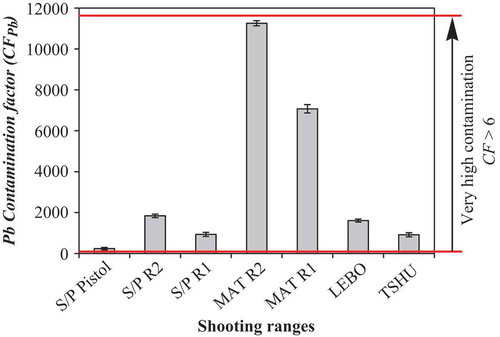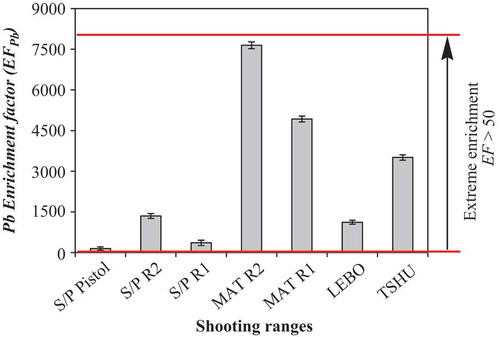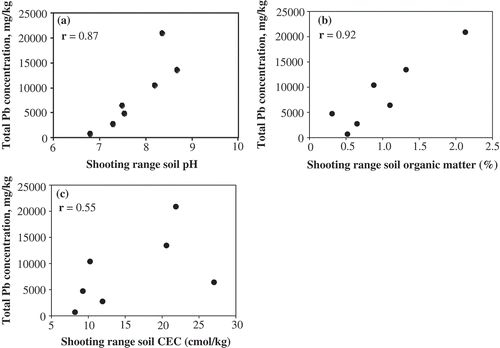ABSTRACT
Risk assessment indices such as risk assessment code (RAC), potential ecological risk index (PERI), geoaccumulation index (Igeo), contamination factor (CF) and enrichment factor (EF) provide a good measure of environmental risk posed by Pb accumulated in shooting range soils as opposed to total Pb concentration. For this reason, the S/P Pistol shooting range, even though accumulated lower concentration of Pb (685±218 mg/kg), exhibited ‘very high risk’ to the environment with RAC value of 77 exceeding the 51 set guideline value for ‘very high risk’ with a significant margin compared to MAT R2 (20888±5419 mg/kg) at RAC value of 48 and highest total Pb concentration. This implies that mobility and bioavailability of Pb at S/P Pistol shooting range will be higher posing a greater risk to biota even though contamination from Pb is low. Best shooting range management practices and low cost remedial actions such as phytoremediation and chemical immobilization should be carried out as soon as possible to minimize the bioavailability and mobility of Pb in the studied shooting ranges.
1. Introduction
Many previous studies have concentrated on total Pb concentrations in shooting range soils omitting quantification of environmental risks associated with such pollution. Elevated concentrations of Pb in the range 300 – 58,300 mg/kg in shooting range soils have been reported in the United States of America, Netherlands, Denmark, Sweden, Finland and England with little information on the risk assessment of such large quantities of Pb deposition [Citation1–Citation6]. The total concentration of Pb only depicts the amount of Pb stored in the environment and does not give details on the bioaccessibility, bioavailability and toxicity of Pb to the biota [Citation7]. In recent years, research into speciation of Pb in shooting range soils has provided information on the extent of Pb mobility and bioavailability [Citation8–Citation12]. However, chemical speciation in this regard involves identification and quantification of the different species and forms of Pb present in shooting range soil compartments [Citation13]. This process details the distribution of Pb among the different soil fractions giving qualitative insight into the main binding sights and phase associations of Pb and its potential ecotoxicity to biota. The chemical speciation identifies Pb species in the soil into the labile and inert fractions [Citation14]. The inert fractions are less hazardous to the environment while the labile fractions are considered toxic and harmful.
Speciation of Pb has been achieved through carrying out such speciation methods and techniques such as the method of sequential extraction by Tessier et al. (1979) [Citation15] and the Bureau Communautaire de Reference (BCR) sequential extraction method [Citation16]. The existence of different chemical forms of Pb in shooting range soils account for the extent of bioaccumulation and uptake of Pb by plants [Citation17]. Some forms of Pb such as lead phosphate (Pb3(PO4)2, lead sulphate(PbSO4), lead sulphite (PbS) and lead chloride phosphate (Pb5(PO4)3Cl are immobile in the soil significantly reducing their bioavailability and translocation in plants [Citation14]. On the other hand, the chemically active fractions of Pb-particulate matter such as lead nitrate (PbNO3), lead acetate (PbCOOCH3) and lead chloride (PbCl2) have the potential to be translocated into plants and contaminate both surface and underground water sources thereby finding their way into the food chain [Citation8,Citation9]. Consequently, Pb speciation provides partial information on the degree and risk of environmental pollution from Pb.
In addition to Pb speciation methods such as the Tessier sequential extraction method and BCR methods, the synthetic precipitation toxicity leaching procedure (SPLP) has also been used to ascertain the extent of Pb pollution of shooting range soils and eventual contamination of surface and underground water [Citation18]. However, the SPLP procedure does not provide an accurate measure of the risk posed by high concentration of Pb in soil to water sources. Metal contaminants such as Pb, their associations with reactive phases and chemical forms are very important controls on their release, transport and environmental impact [Citation9].
The first preliminary investigation into Pb pollution in Botswana emanating from shooting range exercises was first carried out by our research group [Citation19]. This pioneering study looked into the degree of Pb deposition in the various military shooting ranges found in Botswana followed by a study that attempted to ascertain for the speciation and mobility of Pb [Citation20]. The two preceding studies were able to establish that military shooting ranges in Botswana are highly contaminated with Pb, with Pb concentrations reaching highs of 38 406.87 mg/kg [Citation19]. In all the fifteen shooting ranges that have been studied, it was found out that Pb is mostly confined to the carbonate fraction and to a larger extent to the Fe-Mn oxide fraction. It is important to note that no integrated research has focused on the environmental risk assessment of Pb contamination of shooting range soils and this is the first of such kind of attempt. As a consequence, we continue our quest to provide baseline data for the control and risk management of Pb pollution of shooting range soils, four risk assessment methods have been applied in order to determine and ascertain the extent of shooting range soil pollution. The objectives of the current study were; (1) to assess and quantify shooting range soils contamination using five pollution risk assessment methods, namely; (i) risk assessment code (RAC), (ii) potential ecological risk index (PERI), (iii) geolochemical accumulation index (Igeo), (iv) contamination factor (CF) and (v) enrichment factor (EF). The analysis of these results will provide a better comprehension of the environmental risks posed by deposition into shooting range soils of Pb emanating from ammunition used for shooting practices. The investigation into the environmental contamination risk posed by Pb deposition into shooting range soils can help enhance shooting range best management practices, in particular the need for soil cleaning and disposal of contaminated soils. The evaluation of the pollution risk will help inform the choice of method for soil remediation among the many methods that are available such as excavation, phytoremediation, washing techniques, mineralogical techniques and chemical immobilization [Citation21].
2. Materials and methods
2.1. Features and descriptions of study sites
Seven shooting ranges located in the eastern and north eastern part of Botswana were used in this study (). A detailed description of the location of the shooting ranges is given by Kelebemang et al. (2017). All the seven shooting ranges studied were small arms ranges.
2.2. Soil sampling
Soil sampling was done at the berm of the shooting ranges using a soil recovery probe. The berm was divided into three sampling points; upper, middle and lower sampling point. Four soil samples were collected into butyrated zip-lock plastic bags from each sampling point of 150 cm radius along a central transact as shown on below. The soil samples were then transported to Botswana Geoscience Institute (BGI) chemistry laboratory for analysis. A total of 84 soil samples were collected at a depth of 20 cm in seven shooting ranges. At the laboratory, the four soil samples from the three soils were mixed together to make three composite samples for each berm. Background soil samples were collected at a distance of 200 m away from the shooting ranges as control samples.
2.3. Total Pb concentration in shooting range soils
Total Pb concentrations used in this risk assessment study were obtained using inductively coupled plasma optical emission spectrometry (ICP-OES; Perkin Elmer, Optima7300DV) after digestion using USEPA Method 3050 with 1:1 nitric acid. Standard reference material of soil, NCS DC 73,320 was obtained from the Botswana Geoscience Institute (Chemistry Lab) and used for quality assurance after taking it through the same sample preparation procedure as the shooting range soil samples. The total concentration and fractionation data of Pb used in this study for the pollution risk assessment of Pb deposition in shooting range soils were obtained from our previous work [Citation20].
2.4. Pollution risk assessment of Pb deposition in shooting range soils
2.4.1. Risk assessment code (RAC)
The speciation of Pb in the different soil compartments through sequential extraction procedure gives insight into the bioavailability and mobility of Pb in shooting range soils. However, this does not give quantitative information on the risk posed by the bioavailable and labile Pb in the soil. As a result, the risk assessment code (RAC) helps assess the environmental risk posed by the presence of Pb in shooting range soils. It provides a better understanding of the correlation between Pb in bioavailable fractions and Pb mobility, as well as the environmental risk of Pb. The risk assessment code (RAC) was first suggested by Perin et al. (Citation1985) and it describes a hazard number ranking of the shooting ranges from the lowest level of risk (Code 1) to the highest level of risk (Code 5) [Citation22]. This method has been extensively applied in establishing the pollution risk of heavy metals such as Pb [Citation7,Citation23,Citation24]. It is determined from the ratio of metal fractions that are exchangeable or bound to carbonates to the total metal concentrations of all the five fractions as in Equation (1) below [Citation25];
Where C1 and C2 are concentrations of Pb in exchangeable and carbonate fractions respectively, Ct is the total concentration of Pb in all the five fractions. RAC gives a deeper understanding on the bioaccessibility and bioavailability of heavy metals in the soil. The pollution risk level associated with soil contamination from heavy metals is given in below.
Table 1. Risk assessment code (RAC) and corresponding pollution risk level [Citation22].
2.4.2. Potential ecological risk index (PERI)
The risk assessment of environmental pollution from Pb can also be determined through the potential ecological risk index (PERI), initially introduced by Hakanson (Citation1980) [Citation26]. PERI does not only assess the pollution status in shooting range soils but also integrates the ecological and environmental effects with toxicology, providing an effective estimation of the potential risk of Pb contamination with the index level [Citation24,Citation27]. It is made up of three constituents being (1) degree of contamination (CD), (2) toxic-response factor (TR) and (3) potential risk factor (ER). These three constituents of PERI can be determined through the equations given below;
Where CiD is concentration of heavy metal contaminant i in each sampling point of element i; CiR is the reference concentration of heavy metal contaminant i given by the background concentration of the heavy metal in the soil; Cif denotes the pollution coefficient of a single heavy metal; EiR refers to the potential ecological risk index of a single heavy metal; RI signifies the comprehensive potential ecological risk index involving many heavy metals in the system while TiR denotes the biological toxic factor of a single heavy metal as determined by Hakanson (Citation1980). TiR for Pb is 5 [Citation26]. The comprehensive pollution risk from a heavy metal can be obtained through the PERI method. According to Hakanson (Citation1980), the significance of the EiR values can be summarized as in below.
Table 2. Ecological risk index and resultant ecological risk level [Citation26].
2.4.3. Geoaccumulation index (igeo)
The geoaccumulation index compares the accumulated concentration of Pb in shooting range soils to its local background concentration found in the studied area. It is given by the Equation (5) below [Citation28];
Where Ci is the measured concentration of the heavy metal i in the soil while Cb is the local background concentration of heavy metal i. The constant 1.5 is a factor that denotes the background value correlation factor [Citation27]. The extent of contamination of shooting range soils from Pb can be classified according to one of the seven Igeo grades as shown in below.
Table 3. Classification of pollution risk into Igeo grades [Citation27].
2.4.4. Contamination factor (CF)
The contamination factor describes the level of heavy metal contamination in the soil. It is calculated using Equation (6) given below,
where Ci and Cb are the mean concentrations of the target heavy metal in the soil and background respectively. below depicts individual element soil contamination levels [Citation29].
Table 4. Classification of individual metal contamination level [Citation29].
2.4.5. Enrichment factor (EF)
The enrichment factor [EF] provides important knowledge on how anthropogenic activities such as shooting practices have deposited heavy metals into the soils relative to the original unperturbed condition of the soils. A method adapted from Mmolawa et al. (2011) was used to ascertain for environmental pollution due to the shooting practices carried out in Botswana [Citation29].
Where Ci is the concentration of heavy metal i in shooting range soils; median Ci Background is the concentration of heavy metal i in background soils and MAD Ci Background is the median absolute deviation from median with the following definition;
The above definition is read as; find the median of replicate soil concentration of soil background metal i; then subtract the median from each background heavy metal i concentration; take the absolute value of the differences between the individual background heavy metal i concentrations and their median and finally obtain the median of these absolute differences. The extent of soil enrichment can be categorized as depicted in below.
Table 5. Categories of level of soil enrichment from Pb [Citation29].
3. Result and discussion
3.1. Total Pb concentration in seven military shooting ranges
Our preliminary studies were able to establish high concentrations of total Pb in all the seven shooting ranges [Citation20]. Total concentrations of as high as 685 mg/kg to 21,000 mg/kg were found in S/P Pistol and MAT R2 shooting ranges respectively. The lowest total Pb concentration found at S/P Pistol exceeded the 100 mg/kg maximum permissible limit set by the World Health Organization (WHO) [Citation30] and 400 mg/kg as set out by the United States Environmental Protection Agency (USEPA) [Citation20]. Total Pb concentrations measured in shooting range berm soils were more than a thousand times higher than the USEPA 15 µg/L maximum contaminant limit (MCL) and the Botswana Bureau of Standard (BOBS) and World Health Organization (WHO) 10 µg/L of Pb in water which may pose a serious risk to water pollution. Our two previous preliminary studies put emphasis on ascertaining for pollution of shooting ranges from total Pb and the different species of Pb responsible for Pb mobility and bioavailability. However, previous studies have shown that total Pb present in the soil may not necessarily pose a serious pollution threat for as long as it is restricted to the immobile and inert species such as Pb3(PO4)2, PbSO4, PbS and Pb5(PO4)3Cl [Citation14]. In order to establish the mobility and bioavailability of Pb in shooting range soils, we have successively carried out sequential extraction procedures and found out that Pb existed mostly in the carbonate fraction in all the shooting ranges studied. Pb in the carbonate fraction is considered labile and bioavailable, hence the need to quantify the pollution risk associated with such Pb species.
3.2. Speciation of Pb in shooting range soils by applying the sequential extraction procedure
We have shown using the sequential extraction procedure by Tessier et al. (1979) that partitioning of Pb in shooting range soil profiles was mainly in the carbonate fraction [Citation20]. The carbonate (CB) soil compartment held 36–53% of Pb followed by the organic bound (OB) fraction (2–41%) [Citation20]. The eco-toxicity and bioavailability of the fractions has been classified in previous studies as shown in below [Citation31]. The water exchangeable (WE) and carbonate bound (CB) fractions are considered to have direct toxicity and direct effect to the biota while the Fe-Mn oxide (Fe-Mn) and organic bound (OB) have potential toxicity and effect to the biota depending on the favourability of the environmental conditions [Citation31]. Our sequential extraction studies indicate that Pb accumulated in all the seven shooting ranges studied existed in fractions (WE and CB) exhibiting direct toxicity to the ecosystem. The high concentration of Pb distributed in these labile fractions was also found to be directly bioavailable to the biota. It was therefore paramount that this direct toxicity be evaluated and quantified using risk assessment methods and procedures.
Table 6. Eco-toxicity and bioavailability of Pb in the different fractions [Citation31].
3.3. Risk assessment of environmental contamination from Pb deposition
The assessment of shooting range soils contamination was carried out using five pollution risk assessment methods, namely; (i) risk assessment code (RAC), (ii) potential ecological risk index (PERI), (iii) geolochemical accumulation index (Igeo), (iv) contamination factor (CF) and (v) enrichment factor (EF).
3.3.1. Evaluation of risk of environmental pollution using the risk assessment code (RAC) method
In accordance with the RAC guidelines, all the seven shooting ranges pose an environmental pollution risk with RAC of over 37% – 77% experienced by all the shooting ranges (). MAT R1, MAT R2 and LEBO ranges pose ‘high risk’ to the environment with RAC values of 37%, 48% and 49% respectively. The S/P Pistol range posed a ‘very high risk’ to environmental pollution of all the seven shooting ranges studied at an RAC value of 77% and risk assessment code of 5. The S/P Pistol shooting range had a total Pb concentration of 685 ± 218 mg/kg, however this shooting range exhibited a very high pollution risk to the environment compared to other shooting ranges that contained more than three times the total Pb such as the MAT R2 which accumulated the highest concentration of 20,888 ± 5419 mg/kg. This is an indication that the eco-toxicity and bioavailability of Pb in contaminated shooting range soil depends not only on the total concentration but also on the different soil fractions that Pb is confined to in the soil. These are the percentages of Pb species existing in the labile compartment mainly carbonate fraction and water exchangeable. Pb species in these soil fractions can easily enter the food chain. Small variations in environmental conditions such as pH, moisture, cation exchange activity can increase the bio-toxicity of Pb to the biota. These results buttress our earlier findings that all the seven shooting ranges experienced high Pb mobility factor of over 90% in all the shooting ranges [Citation20]. The implication of our investigations is that, there are high chances that Pb deposited into shooting range soils will be mobilized into nearby surroundings which mostly are agricultural areas as soil conditions become favorable leading to contamination of soils in such areas. The high risk assessment codes also correlates well with the high bioavailability factor determined in our previous study [Citation20]. Other previous studies have also found that Pb presented a high pollution risk to the environment with RAC > 40 at both the We-rye and Cho-do shooting ranges studied in the Republic of Korea [Citation32]. High RAC values of up to 44.5 have successfully quantified the pollution risk posed by accumulation of cadmium (Cd) in shooting range soils [Citation33] The high RAC’s experienced by the soils in the seven shooting ranges studied triggers the urgency of taking some remedial actions in order to minimize the spread of pollution before it spirals out of control. Islam et al. (2017) were able to show that immobilization of Pb using hydrothermal treatment greatly reduced the percentage of Pb associated with the labile fractions (carbonate bound and water exchangeable) and thereby greatly decreasing the pollution risk of Pb [Citation34]. A drastic decrease in the RAC values of 41.33% for the untreated soils were much lower than those of the treated soils at 14.66% implying redistribution of Pb in the inert compartments after the hydrothermal treatment. Other studies have shown that the labile CB and WE fractions could be transformed into stable fractions after the subcritical water treatment (SCW) process at high temperatures [Citation33].
3.3.2. Assessment of the ecological and environmental effects of Pb pollution using the potential ecological risk index (PERI)
All the seven shooting ranges studied experienced an unprecedented high ecological risk index (≫320). Our findings imply very high Pb pollution of shooting range soils (). Potential ecological risk index was in the range 1192–56,272, exceedingly larger than required by the guidelines. Even though all the seven shooting ranges posed high risk to the ecological system of the environment, MAT R2 was found to possess immense risk to the environment at ecological risk index of well over 50,000. Previous studies by Shen et al. (2017) have determined potential ecological risk index of up to 1158 for heavy metals such as Cd in soils [Citation35]. Islam et al. (2016) were able to find that the ecological potential risk indices of Pb in shooting range soils were 3446 and 725 at Cho-do and We-rye respectively, implying a very high risk to the biota [Citation32]. It is important to note that PERI evaluates the relative sensitivity of the biota to toxic Pb and gives a measure of the potential ecological risk caused the toxic Pb element. Such high ecological risk indices call for remedial actions to be employed immediately in order to arrest the situation before it spirals out of control. Preliminary control measures such as the immobilization of Pb in the soil can be taken as initial measures to curb the mobility and bioavailability of Pb. Immobilization techniques and methods such as chemical [Citation36], phytoremediation [Citation37] and hydrothermal treatment [Citation34] have been employed in restricting the mobility of Pb.
3.3.3. Comparison of the accumulated Total Pb and background Pb concentrations by applying the geoaccumulation index (Igeo) approach
The geoaccumulation indices (Igeo) were in the range 7.3–12.8, much high than the extreme limit of 5, an indication of extremely polluted shooting range soils (). This implied that the shooting practice anthropogenic activity has to a very large extent contributed to the soil contamination from Pb relative to the background Pb concentrations which were in the range 1.90–16.1 mg/kg [Citation20]. These findings corroborate the RAC and PERI results discussed earlier. MAT R2 experienced the highest pollution from Pb of all the shooting ranges. The Igeo correlates well with total Pb concentration found at MAT R2 which accumulated the largest concentration of Pb. High Igeo values for Pb in shooting ranges have also been recorded in other previous studies. Islam et al. (2016) were able to determine that the two shooting ranges they investigated were highly polluted with Pb at Igeo values of 6.6 and 8.8 [Citation32]. Urrutia-Goyes et al. (2017) established that the soil in a historic shooting range to be rehabilitated into a public urban park in Greece was extremely polluted mainly with Pb at an alarming Igeo values of 5.95 to 6.31 [Citation38]. Their study was also able to establish the high non-carcinogenic risk posed by high concentrations of Pb in the soil. The Igeo results support the RAC and PERI results, an indication that the military shooting ranges are highly polluted with Pb and that remedial actions should be implemented as soon as possible since all these ranges are still in use.
3.3.4. Determination of level of pollution through the contamination factor (CF)
The contamination factors (CB) were found to be high for the soils in all the seven shooting ranges studied indicating very high contamination (). The MAT R2 shooting range was again found to have accumulated the highest amount of Pb at contamination factor (CF) of 11,255 depicting a highly contaminated shooting range (). The high CF in these shooting ranges imply high retention time of Pb in the soil and increased risk to the environment [Citation27]. The high CF in the seven shooting ranges correlates well with the RAC, PERI and Igeo findings which all showed elevated risk from Pb to biota.
3.3.5. Evaluation of the anthropogenic impact of Pb in the soil using the enrichment factor (EF) approach
The anthropogenic impact of Pb in the seven shooting ranges soils was evaluated using the enrichment factor (EF) approach. The concentrations of total Pb in the shooting ranges arising from shooting activities were compared with the background Pb concentrations in order to establish the degree of pollution brought about by shooting practices. Enrichment factors of much higher than 50 showed extreme enrichment (). The enrichment factors were in the range 146 to 7467 with MAT R2 shooting range exhibiting extreme Pb enrichment among all the shooting ranges studied (). The enrichment factor results correlate well with the RAC, PERI, Igeo and CF risk assessment indices, an indication of high level of pollution of shooting ranges and potential risk to the ecosystem. Extremely high Pb enrichment in shooting ranges has also been reported elsewhere in Pantex shooting range soils (Texasm USA), with enrichment factor of over 277 and total Pb concentration of up to 4675 mg/kg [Citation39]. Extremely high Pb enriched shooting range soils were found in Kesariani, Greece, possessing an enrichment factor of 115 [Citation38]. The degree of soil enrichment with Pb can help in deciding the best remedial method soil cleaning and reclamation.
3.4. Statistical analysis
Pearson correlation coefficient (r) was carried out in order to establish the effects of physico-chemical properties of the soil on the degree of Pb pollution of shooting ranges. The significance of the Pearson correlation coefficient is shown on below.
Table 7. Pearson correlation coefficient (r) range and corresponding significance [Citation24].
The relationship between the total Pb concentration of shooting range soils and the accompanying soil pH show a positive direct correlation (r = 0.87) between pH of the soil and the deposition of Pb into the soil ()). In our preliminary studies we have shown that at high pH the stability of the Pb fractions is enhanced leading to high total Pb concentrations in the soil and thereby increasing pollution risk to the ecosystem [Citation19,Citation20]. We have also shown that MAT R2 displayed high accumulation of carbonate bound Pb at an alkaline pH of 8.36 [Citation20]. A high Pearson correlation coefficient of r = 0.92 also showed a direct relationship between the risk of environmental pollution from Pb and organic matter present in the shooting range soil ()). The cation exchange capacity (CEC) of the soil plays an important role in the mobility and bioavailability of Pb. A medium positive direct correlation (r = 0.55) was found between the soil CEC and high concentration of Pb accumulated on shooting range soils ()). MAT R2 experienced the highest concentration of Pb with the highest CEC value of 21.87 cmol/kg. The binding capacity of Pb to other species is increased in soils with higher CEC leading to reduced mobility and bioavailability of Pb [Citation40]. Previous studies have found elevated Pb concentrations of 48 400 mg/kg in MPR shooting ranges possessing high CEC of 43.2 cmol/kg compared to Pb concentration of 12 710 mg/kg with corresponding CEC of 8.51 cmol/kg at TRR shooting range [Citation41].
4. Conclusion
This study is the first in Botswana to assess the risk associated with Pb pollution of shooting range soils, providing a baseline for future studies on shooting range soil pollution from Pb. Measurement of total Pb concentrations in shooting range soils alone does not give a true picture of the extent and risk posed by such soil contamination. It is important to quantify the risk to biota involved with such high concentrations of Pb stored in the soil. Risk assessment indices such as risk assessment code (RAC), potential ecological risk assessment index (PERI), geoaccumulation index (Igeo), contamination factor (CF) and enrichment factor (EF) have indicated that soils in all the seven shooting ranges studied were highly polluted with Pb presenting high mobility, bioavailability and bioaccessibility to the ecosystem. The seven shooting ranges exhibited ‘high risk’ to ‘very high risk’ to biota with RAC values of 37–77%. PERI values were in the range 1192–56,272, way greater than the 320 suggesting ‘very high risk’ to the ecological system. The high risk to the ecosystem displayed by Pb pollution calls for immediate and aggressive soil remediation processes in order to reduce the mobility and bioavailability of Pb. The geoaccumulation indices were all greater than 5 in the range 7.3–12.8, an indication of extreme risk to the environment. The Igeo gives a clear picture of the extent of Pb deposition into the soil brought about by anthropogenic activities relative to the background Pb concentrations. In addition, CF ≫6 in all the seven shooting ranges studied, an indication of very high contamination of shooting range soils. Contamination factor (CF) of as high as 11,255 was determined for soils at MAT R2 shooting range. High Pb enrichment of shooting range soils corroborated the contamination factor results as an EF value of 7467 was obtained for MAT R2 soils. It is also important to note that, MAT R2 exhibited higher values of the risk assessment indices correlating well with the high total Pb concentrations of 20,888 mg/kg found at this shooting range. Best shooting range management practices and soil remediation and reclamation methods and techniques need to be carried out as a matter of urgency at these shooting ranges. Some cost effective remedial methods such as immobilization of Pb with lime and phosphorus to help reduce the mobility and bioavailability of Pb. This remedial method is also good since it does not lead to soil removal and possible loss of habitat and biota.
Acknowledgments
The authors would like to thank Botswana Defence Force (BDF) for the assistance they provided during the sampling exercise and identifying the shooting ranges. We are also grateful to the Botswana Geoscience Institute (BGI) for their assistance with ICP-OES instrument for Pb analysis.
Disclosure statement
The authors report no conflict of interest.
Additional information
Funding
References
- Hui CA. Lead distribution throughout soil, flora and an invertebrate at a wetland skeet range. J Toxicol Environ Health A. 2002;65:1093–107.
- VanBon J, Boersema JJ. Sources, effects and management of metallic lead pollution: the contribution of hunting, shooting and angling. Contam Soil. 1988;3:269–271.
- Astrup T, Boddum JK, Christensen TH. Lead distribution and mobility in a soil embankment used as a bullet stop at a shooting range. J Soil Contam. 1999;8:653–665.
- Bruell R, Nikolaidis NP, Long RP. Evaluation of remedial alternatives of lead from shooting range soil, Environ. Eng Sci. 1999;16:403–414.
- Camobreco VJ, Richards BK, Steenhuis TS, et al. Movement of heavy metals through undisturbed and homogenized soil columns. Soil Sci. 1996;161:740–750.
- Cao X, Ma LQ, Hardison JD, et al. Weathering of lead bullets and their environmental effects at outdoor shooting ranges. J Environ Qual. 2003;32:526–534.
- Zhang J, Yang B, Chen T, et al. Metal speciation and pollution assessment of Cd and Pb in intertidal sediments of Donghai Island, China. Reg Stud Mar Sci. 2016;6:37–48.
- Ashraf MA, Maah MJ, Yusoff I. Speciation of heavy metals in the sediments of former tin mining catchment. Iran J Sci Technol. 2012;36:163–180.
- Ashraf MA, Maah MJ, Yusoff I, et al. Speciation of heavy metals in the surface waters of a former tin miningcatchment. Chem Speciation Bioavailability. 2012;24:1–12.
- Van Vleek B, Amarasiriwardena D, Xing B. Investigation of distribution of soil antimony using sequential extraction and antimony complexed to soil-derived humic acids molar mass fractions extracted from various depths in a shooting range soil. Microchem J. 2011;97:68–73.
- Chrastny V, Komarek M, Hajek T. Lead contamination of an agricultural soil in the vicinity of a shooting range. Environ Monit Assess. 2010;162(1–4):37–46.
- Ma LQ, Hardison D Jr., Harris WG, et al. Effects of soil property and soil amendment on weathering of abraded metallic Pb in shooting ranges. Water Air Soil Pollut. 2007;178:297–307.
- Abdallah MAM. Chemical speciation and contamination assessment of Pb and V by sequential extraction in surface. Arab J Chem. 2017;10:68–75.
- Rachou J, Sauve S. Evaluation of affinity constants of Cu, Cd, Ca and H for active soil surfaces for a solid phase controlled soil ligand model. Environ Chem. 2008;5:150–160.
- Tessier A, Campbell PGC, Bisson M. Sequential extraction procedure for the speciation of particulate trace metals. Anal Chem. 1979;51:844–851.
- Mossop KF, Davidson CM. Comparison of original and modified BCR sequential extraction procedures for the fractionation of copper, iron, lead manganese and zinc in soils and sediments. Anal Chimi Acta. 2003;478:111–118.
- Fernandez-Ondono E, Bacchetta G, Lallena AM, et al. Use of BCR sequential extraction procedures for soils and plant metal transfer predictions in contaminated mine tailings in Sardinia. J Geochem Explor. 2017;172:133–141.
- Fayiga AO, Saha UK. Effect of phosphate treatment on Pb leachability in contaminated shooting range soils. Soil Sediment Contam. 2017;26:115–126.
- Sehube N, Kelebemang R, Totolo O, et al. Lead pollution of shooting range soils. S Afr J Chem. 2017;70:21–28.
- Kelebemang R, Dinake P, Sehube N, et al. Speciation and mobility of lead in shooting range soils. Chem Speciat Bioavailab. 2017;29:143–152.
- Sorvari J, Antikainen R, Pyy O. Environmental contamination at Finnish shooting ranges—the scope of the problem and management options. Sci Total Environ. 2006;366:21–31.
- Perin G, Craboledda L, Lucchese M, et al. Heavy metal speciation in the sediments of Northern Adriatic Sea—a new approach for environmental toxicity determination. In: Lakkas TD, editor. Heavy Metal in the Environment 2. CEP Consultants, Edinburgh. 1985. p. 454–456.
- Pejman A, Bidhendi GN, Ardestani M, et al. Fractionation of heavy metals in sediments and assessment of their availability risk: A case study in the northwestern of Persian Gulf. Mar Pollut Bull. 2017;114:881–887.
- Ke X, Gui S, Huang H, et al. Ecological risk assessment and source identification for heavy metals in surface sediment from the Liaohe River protected area, China. Chemosphere. 2017;175:473–481.
- Gu Z, Wu M, Li K, et al. Variation of heavy metal speciation during the pyrolysis of sediment collected from the Dianchi Lake, China. Arab J Chem. 2017;10:2196–2204.
- Hakanson L. An ecological risk index for aquatic pollution control. A sedimentological approach. Water Res. 1980;14:975–1001.
- Matong JM, Nyaba L, Nomngongo PN. Fractionation of trace elements in agricultural soils using ultrasound assisted sequential extraction prior to inductively coupled plasma mass spectrometric determination. Chemosphere. 2016;154:249–257.
- Li Y, Zhang H, Tua C, et al. Occurrence of red clay horizon in soil profiles of the Yellow River Delta: implications for accumulation of heavy metals. J Geochem Explor. 2017;176:120–127.
- Mmolawa KB, Likuku AS, Gaboutloeloe GK. Assessment of heavy metal pollution in soils along major roadside areas in Botswana. Afr J Environ Sci Technol. 2011;5:186–196.
- Adejoh IP. Assessment of heavy metal contamination of soil and cassava plants within the vicinity of a cement factory in north central, Nigeria. Adv Appl Sci Res. 2016;7:20–27.
- Li L, Xu ZR, Zhang C, et al. Quantitative evaluation of heavy metals in solid residues from sub- and super-critical water gasification of sewage sludge. Bioresour Technol. 2012;121:169–175.
- Islam MN, Nguyen XP, Jung HY, et al. Chemical speciation and quantitative evaluation of heavy metal pollution hazards in two army shooting range backstop soils. Bull Environ Contam Toxicol. 2016;96:179–185.
- Islam MN, Jung HY, Park JH. Subcritical water treatment of explosive and heavy metals co-contaminated soil: removal of the explosive, immobilization and risk assessment of heavy metals. J Environ Manag. 2015;163:262–269.
- Islam MN, Park JH. Immobilization and reduction of bioavailability of lead in shooting range soil through hydrothermal treatment. J Environ Manag. 2017;191:172–178.
- Shen F, Liao R, Ali A, et al. Spatial distribution and risk assessment of heavy metals in soil near a Pb/Zn smelter in Feng County, China. Ecotoxicol Environ Saf. 2017;139:254–262.
- Tandy S, Meier N, Schulin R. Use of soil amendments to immobilize antimony and lead in moderately contaminated shooting range soils. J Hazard Mater. 2017;324:617–625.
- Beiyuan J, Awad YM, Beckers F, et al. Mobility and phytoavailability of As and Pb in a contaminated soil using pine sawdust biochar under systematic change of redox conditions. Chemosphere. 2017;178:110–118.
- Urrutia-Goyes R, Argyraki A, Ornelas-Soto N. Assessing lead, nickel, and zinc pollution in topsoil from a historic shooting range rehabilitated into a public urban park. Int J Environ Res Public Health. 2017;14:698–712.
- Basunia S, Landsberger S. Contents and leachability of heavy metals (Pb, Cu, Sb, Zn,As) in soil at the pantex firing range, Amarillo, Texas. J Air Waste Manag Assoc. 2001;51:1428–1435.
- Cheng SF, Huang CY, Lin MS. Sodium acetate method for determining CEC of cadmium-contaminated soil. Sustain Environ Res. 2012;22:85–89.
- Cao X, Ma LQ, Chen M, et al. Weathering of lead bullets and their environmental effects at outdoor shooting ranges. J Environ Qual. 2003;32:526–534.

